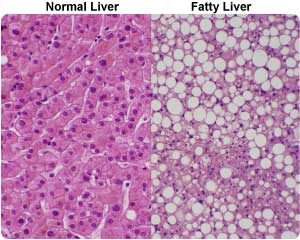
Hepatic steatosis, also known as fatty liver disease or simply as fatty liver, is probably the most common liver disease. It strikes an estimated twenty percent of the American adult population. Globally, it ranges from nine to almost forty percent of the population depending on location, with the advanced world and southern China leading the statistical occurrences. Why southern China should have such a high occurrence of the illness is not yet decisively known.
The disease manifests as fatty deposits in the liver. It isn’t a serious or life threatening illness in itself, but it can be the first stage or first sign of more serious liver illnesses such as liver cancer and cirrhosis of the liver. As such, fatty liver is a cause for concern and calls for monitoring and treatment.
Types & Causes
There are two types of hepatic steatosis based on the cause of the illness. These are alcoholic and non-
However, there are some common associations with the illness where alcohol abuse is not present. The main ones are obesity and diabetes. The nature and progress of the illness is essentially the same for alcoholic and non-
Other Causes
In addition to alcohol, obesity, and diabetes, fatty liver disease can also result from several other causes. Some prescription medications have been implicated in the disease. These include corticosteroids, some antiviral medications (e.g. nucleoside analogs), tetracycline (an antibiotic), and several others.
Soft drinks have also been found to have a correlation with fatty liver. This is probably due to the presence of large amounts of high fructose corn syrup. Consumption of large amounts of sugar has essentially the same effect. There are also genetic factors involved. Male Indians have a higher than normal incidence of non-
Diagnosis
Hepatic steatosis seldom shows overt symptoms. It is usually discovered either by accident while testing for something else or through proactive testing when a high risk factor such as alcoholism or obesity is known to be present. The first indication of hepatic steatosis is usually a blood test revealing elevated liver enzymes. In particular, the enzymes ALT (alanine aminotranferase) and AST (aspartate aminotransferase) are measured in the blood. Some confirming tests showing damage to the liver or loss of liver function are usually done after the preliminary finding. A third test is to use medical imaging techniques (typically an ultrasound) to view the liver. The fat deposits are normally visible when hepatic steatosis is present.
After hepatic steatosis is definitely identified, the next step in diagnosing the illness is to conduct a lifestyle survey to try to determine the cause. The first question is how much alcohol the patient consumes on a regular basis. If this is more than two drinks a day on the average (especially if it is significantly more or if the patient is an alcohol addict), a diagnosis of alcoholic fatty liver disease is called for. If not, then another cause is sought. The patient’s body weight, diet, and exercise regime are all examined, along with tests for glucose tolerance to determine whether the patient suffers from diabetes. Identifying the cause of the illness is very important as there is no direct treatment for fatty liver disease as such. Treatment consists of correcting the causative factors.
Treatment
Although it is not itself a dangerous illness, hepatic steatosis once diagnosed is always reason for treatment. That’s because it can be a first sign or first stage of liver diseases that are far more serious, such as cirrhosis of the liver.
The treatment for fatty liver disease always involves addressing the underlying causes of the illness. If the diagnosis is alcoholic steatosis, the prescription is to cease drinking alcohol. In severe cases of alcohol addiction, this may require treatment of withdrawal symptoms in a hospital setting. Withdrawal symptoms of alcohol are very severe and can even be life-
follow-
In cases of non-